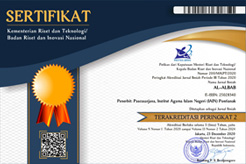The Sasak People of Lombok: Indigenous Communities at The Crossroads of Globalization
Abstract
Keywords
Full Text:
PDFReferences
Asnawi. (2005). Respon Kultural Masyarakat Sasak Terhadap Islam.” Ulumuna IX Edisi 15 Nomor 1.
Bartholomew, J. R. (2001). Alif Lam Mim; Kearifan Masyarakat Sasak, Terjemah Imron Rosyidi. Yogyakarta: Tiara Wacana.
Budiwanti, E. (2000). Islam Sasak: Wetu Telu versus Waktu Lima. Yogyakarta: LKiS, 2000.
H.L., W. (?). Kebudayaan Sasak. Presented at the Paras Kebudayaan Lombok, Lombok.
Keohane, R. O. & Joseph, S. N. (2000). Globalization: What’s New? What’s Not? (And So What?).” Foreign Policy, no. 118 (2000): 104–19. https://doi.org/10.2307/1149673.
Kraan, A. V. d. (2009). Lombok: Penaklukan, Penjajahan, Dan Keterbelakangan 1870-1940. Mataram: Lengge Publisher.
Marrison, G. E. (1999). Sasak and Javanese. Leiden: KITLV Press.
McGrew, A. (2001). Globalization and Global Politics. In The Globalization of World Politics, Vol. second edition. oxford: Oxford University Press.
Ritzer, G. & Dougles, J. G. (2004). Teori Sosiologi Modern. Jakarta: Prenada Media Group.
Rudy, M. T. (2003). Hubungan Internasional Kontemporer dan Masalah Masalah Global. Bandung: Rafika Aditama.
Salehudin, A. (2018). The Face of Mountainous Islam: The Dynamic of Islam in the Dieng Mountains Wonosobo, Central Java, Indonesia. ESENSIA: Jurnal Ilmu-Ilmu Ushuluddin.
http://ejournal.uin-suka.ac.id/ushuluddin/esensia/article/view/1477/1219.
--------. (2018). Revitalisasi Identitas Diri Komunitas Masjid Saka Tunggal Banyumas, Masjid Raya Al Fatah Ambon, Dan Masjid Agung Jami’ Singaraja Bali Dalam Perubahan Budaya Global.” Religió: Jurnal Studi Agama-Agama 8, no. 1 (October 11, 2018): 1–28.
Sinaga, M. L. (2004). Identitas Poskolonial Gereja Suku Dalam Masyarakat Sipil. Yogyakarta: LKiS, 2004.
Standing, G. (2011). The Precariat: The New Dangerous Class. New York: Bloomsbury Academic.
Tahir, M. (2012). Tradisi Merariq (Kawin Lari) Dalam Masyarakat Sasak (Sebuah Telaah Konsepsi, Responsi, Dan Implikasi).” In Harga Diri Dan Ekspresi Budaya Lokal: Suju-Suku Bangsa Di Indonesia, 35–76. Yogyakarta: Laboratorium Religi dan Budaya Lokal (Label).
Wolf, M. (2007). Globalisasi Jalan Menuju Kesejahteraan. Jakarta: Yayasan Obor Indonesia.
http://lombok.panduanwisata.id/wisata-sejarah/menengok-sejarah-masa-silam-lombok-di-kawasan-ampenan-kuno, Accessed December 19, 2018
http://makassar.tribunnews.com/2016/06/14/ada-5-budaya-adat-di-indonesia-sudah-punah-alhamdulillah-bukan-di-sulsel. Accessed November 4, 2018.
http://portalsatu.com/read/budaya/14-bahasa-daerah-di-indonesia-yang-punah-15197. Accessed November 4, 2018.
https://ganaislamika.com/islam-di-lombok-8-masjid-kuno-bayan-beleq-2/. “Islam Di Lombok (8): Masjid Kuno Bayan Beleq (2) – Gana Islamika.” Accessed December 25, 2018.
https://www.wisatadilombok.com/2015/01/masjid-kuno-bayan-masjid-tertua-di.html. Accessed December 25, 2018.
Article Metrics
 Abstract views: 3107
Abstract views: 3107
 PDF views: 1741
PDF views: 1741











